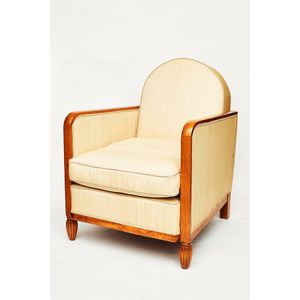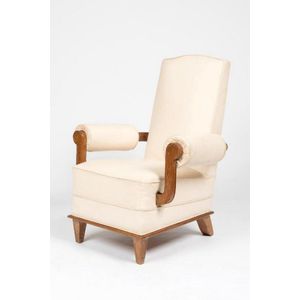French Art Deco Armchair by Charles Dudouyt
You must be a subscriber, and be logged in to view price and dealer details.
Subscribe Now to view actual auction price for this item
When you subscribe, you have the option of setting the currency in which to display prices to $Au, $US, $NZ or Stg.
- Art Deco Period - The Art Deco period was a cultural movement that emerged in the 1920s and 1930s, and was characterized by its emphasis on modernism, luxury, and elegance. The name "Art Deco" comes from the Exposition Internationale des Arts Décoratifs et Industriels Modernes, a large exhibition held in Paris in 1925 that showcased the latest trends in decorative arts.
Art Deco was a reaction against the ornate and elaborate styles of the previous era, and reflected a new modern sensibility. It was characterized by streamlined, geometric shapes, bright colours, and the use of new materials such as chrome, glass, and Bakelite. Art Deco designers sought to create a sense of luxury and sophistication, often incorporating expensive materials such as ivory, marble, and rare woods.
Art Deco had a significant impact on a wide range of artistic fields, including architecture, fashion, graphic design, and interior design. Some of the most iconic examples of Art Deco architecture include the Empire State Building in New York City, the Hoover Building in London, and the Palais de Chaillot in Paris.
The Art Deco period came to an end in the 1940s, as World War II and changing cultural trends led to a shift in artistic styles. However, Art Deco remains an important influence on design and art, and continues to be celebrated for its modernist sensibility and glamorous aesthetic. - Provenance - A term used to describe the provable history of an antique or work of art, and thus an additional aid to verifying its authenticity. Provenance can have an inflating effect on the price of an item, particularly if the provenance relates to the early settlement of Australia, a famous person, or royalty. Less significant are previous sales of the item through an auction house or dealer.
- Attributed - A cataloguing term where the item in the opinion of the cataloguers, is a of the period of the artist, craftsman or designer, and which probably in whole or part is the work of that person.
This item has been included into following indexes:
-
chairs, singles / pairs / threes, style or period
- armchairs 1,767
- Art Deco style 69
- French 962
Visually similar items

French Art Deco armchair, c. 1930, rounded back, seat and sides upholstered in a cream fabric, on two front fluted legs and two back square tapered legs, height 84 cm, width 63 cm, depth 70 cm. Provenance: Copeland & de Soos, Woollahra, c. 1980. Private co

German Lounge Armchair, c. 1940, oak and green velvet upholstery, height 81 cm, width 60.5 cm, depth 79 cm. Provenance: Tyrone Dearing, Elizabeth Bay. Private Collection, Sydney

Schulim Krimper (Australian, 1893-1971), three seater sofa, c. 1960, with ochre brown velvet upholstery, height 78 cm width 225 cm depth 80 cm. Provenance: Private Collection Caulfield, VIC

O. Noel Coulson (1905-1993), pair of upholstered open arm chairs, c. 1958 manufactured by S. Andrewartha furniture Manufacturers, Richmond, Melbourne, limed oak frames, fluted square front legs with brass sabots (2). Height 80 cm, width 60 cm, depth 77 cm.
